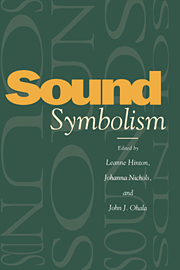Book contents
- Frontmatter
- Contents
- List of contributors
- 1 Introduction: Sound-symbolic processes
- PART I Native American languages north of Mexico
- PART II Native languages of Latin America
- PART III Asia
- PART IV Australia and Africa
- 12 Yir-Yiront ideophones
- 13 African ideophones
- PART V Europe
- PART VI English
- PART VII The biological bases of sound symbolism
- Index
12 - Yir-Yiront ideophones
Published online by Cambridge University Press: 04 August 2010
- Frontmatter
- Contents
- List of contributors
- 1 Introduction: Sound-symbolic processes
- PART I Native American languages north of Mexico
- PART II Native languages of Latin America
- PART III Asia
- PART IV Australia and Africa
- 12 Yir-Yiront ideophones
- 13 African ideophones
- PART V Europe
- PART VI English
- PART VII The biological bases of sound symbolism
- Index
Summary
Introduction
Yir-Yoront (hereafter YY) and the other languages of its area (central to southwestern Cape York Peninsula, Australia) feature a high frequency of ideophones in ordinary and mythic narrative. Ideophones are word-like elements that suggest the sound, in a highly conventionalized sense, that accompanies an action. An example is trrra, as in Kalq ‘trrra yoyrrin “[he] gathered together the spears [suddenly, with a trrra sound].” The relation of the sound of the ideophone to the sound of the action it represents is frequently more remote and arbitrary: tor (of hitting), as in Par-poq ‘tor pin’ y “I hit it on the head, tor!” pup (of falling), as in Pup thilhth “pup! [it] fell”; chart (of hanging, as in a tree), as in Lalpuym chart wenhth “chan! [he] hung up the bundle.”
Some ideophones seem to represent the feel of an action at least as much as the sound, like chawarrq (of picking something up), as in Kalq cha′warrq yiw ‘l “chawarrq! he got the spear.” At the extreme of the scale of arbitrariness is a form like tak (of finishing an action), as in Lalpuym tak kuy “tak! [he] tied up the bundle,” which doesn't appear to represent any typical sound at all.
As with ideophones in other languages, the status of ideophones in a linguistic analysis of YY is problematic. I examine some of the problems below, particularly with regard to phonology (12.2) and syntax (12.6). YY ideophones are also of interest in the study of historical-comparative problems (discussed in 12.4) and of semantics (12.5).
- Type
- Chapter
- Information
- Sound Symbolism , pp. 161 - 177Publisher: Cambridge University PressPrint publication year: 1995
- 7
- Cited by



